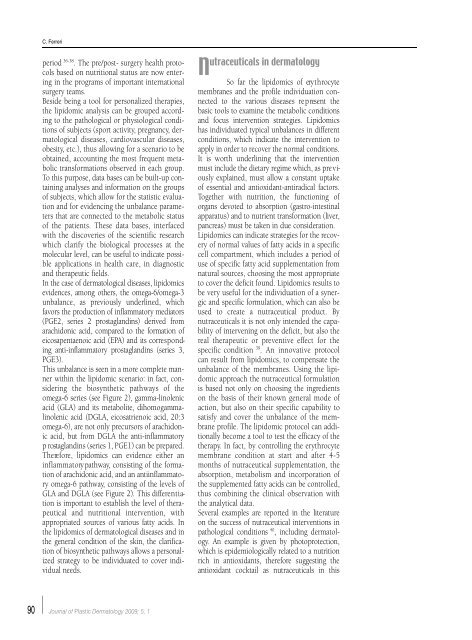Vol. 5, n. 1, January-March 2009 1th International ... - Salute per tutti
Vol. 5, n. 1, January-March 2009 1th International ... - Salute per tutti
Vol. 5, n. 1, January-March 2009 1th International ... - Salute per tutti
You also want an ePaper? Increase the reach of your titles
YUMPU automatically turns print PDFs into web optimized ePapers that Google loves.
90<br />
C. Ferreri<br />
<strong>per</strong>iod 36-38 . The pre/post- surgery health protocols<br />
based on nutritional status are now entering<br />
in the programs of important international<br />
surgery teams.<br />
Beside being a tool for <strong>per</strong>sonalized therapies,<br />
the lipidomic analysis can be grouped according<br />
to the pathological or physiological conditions<br />
of subjects (sport activity, pregnancy, dermatological<br />
diseases, cardiovascular diseases,<br />
obesity, etc.), thus allowing for a scenario to be<br />
obtained, accounting the most frequent metabolic<br />
transformations observed in each group.<br />
To this purpose, data bases can be built-up containing<br />
analyses and information on the groups<br />
of subjects, which allow for the statistic evaluation<br />
and for evidencing the unbalance parameters<br />
that are connected to the metabolic status<br />
of the patients. These data bases, interfaced<br />
with the discoveries of the scientific research<br />
which clarify the biological processes at the<br />
molecular level, can be useful to indicate possible<br />
applications in health care, in diagnostic<br />
and therapeutic fields.<br />
In the case of dermatological diseases, lipidomics<br />
evidences, among others, the omega-6/omega-3<br />
unbalance, as previously underlined, which<br />
favors the production of inflammatory mediators<br />
(PGE2, series 2 prostaglandins) derived fro m<br />
arachidonic acid, compared to the formation of<br />
eicosapentaenoic acid (EPA) and its corre s p o n ding<br />
anti-inflammatory prostaglandins (series 3,<br />
PGE3).<br />
This unbalance is seen in a more complete manner<br />
within the lipidomic scenario: in fact, considering<br />
the biosynthetic pathways of the<br />
omega-6 series (see Figure 2), gamma-linolenic<br />
acid (GLA) and its metabolite, dihomogammalinolenic<br />
acid (DGLA, eicosatrienoic acid, 20:3<br />
omega-6), are not only precursors of arachidonic<br />
acid, but from DGLA the anti-inflammatory<br />
p rostaglandins (series 1, PGE1) can be pre p a re d .<br />
T h e re f o re, lipidomics can evidence either an<br />
i n f l a m m a t o ry pathway, consisting of the formation<br />
of arachidonic acid, and an antiinflammatory<br />
omega-6 pathway, consisting of the levels of<br />
GLA and DGLA (see Figure 2). This diff e re n t i ation<br />
is important to establish the level of therapeutical<br />
and nutritional intervention, with<br />
a p p ropriated sources of various fatty acids. In<br />
the lipidomics of dermatological diseases and in<br />
the general condition of the skin, the clarification<br />
of biosynthetic pathways allows a <strong>per</strong>sonalized<br />
strategy to be individuated to cover individual<br />
needs.<br />
Journal of Plastic Dermatology <strong>2009</strong>; 5, 1<br />
utraceuticals in dermatology<br />
N<br />
So far the lipidomics of ery t h ro c y t e<br />
membranes and the profile individuation connected<br />
to the various diseases re p resent the<br />
basic tools to examine the metabolic conditions<br />
and focus intervention strategies. Lipidomics<br />
has individuated typical unbalances in diff e re n t<br />
conditions, which indicate the intervention to<br />
apply in order to recover the normal conditions.<br />
It is worth underlining that the interv e n t i o n<br />
must include the dietary regime which, as pre v iously<br />
explained, must allow a constant uptake<br />
of essential and antioxidant-antiradical factors.<br />
Together with nutrition, the functioning of<br />
o rgans devoted to absorption (gastro - i n t e s t i n a l<br />
apparatus) and to nutrient transformation (liver,<br />
p a n c reas) must be taken in due consideration.<br />
Lipidomics can indicate strategies for the recovery<br />
of normal values of fatty acids in a specific<br />
cell compartment, which includes a <strong>per</strong>iod of<br />
use of specific fatty acid supplementation from<br />
natural sources, choosing the most appropriate<br />
to cover the deficit found. Lipidomics results to<br />
be very useful for the individuation of a synergic<br />
and specific formulation, which can also be<br />
used to create a nutraceutical product. By<br />
nutraceuticals it is not only intended the capability<br />
of intervening on the deficit, but also the<br />
real therapeutic or preventive effect for the<br />
specific condition 39 . An innovative protocol<br />
can result from lipidomics, to compensate the<br />
unbalance of the membranes. Using the lipidomic<br />
approach the nutraceutical formulation<br />
is based not only on choosing the ingredients<br />
on the basis of their known general mode of<br />
action, but also on their specific capability to<br />
satisfy and cover the unbalance of the membrane<br />
profile. The lipidomic protocol can additionally<br />
become a tool to test the efficacy of the<br />
therapy. In fact, by controlling the erythrocyte<br />
membrane condition at start and after 4-5<br />
months of nutraceutical supplementation, the<br />
absorption, metabolism and incorporation of<br />
the supplemented fatty acids can be controlled,<br />
thus combining the clinical observation with<br />
the analytical data.<br />
Several examples are reported in the literature<br />
on the success of nutraceutical interventions in<br />
pathological conditions 4 0 , including dermatolo<br />
g y. An example is given by photopro t e c t i o n ,<br />
which is epidemiologically related to a nutrition<br />
rich in antioxidants, there f o re suggesting the<br />
antioxidant cocktail as nutraceuticals in this

















